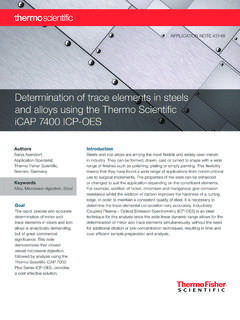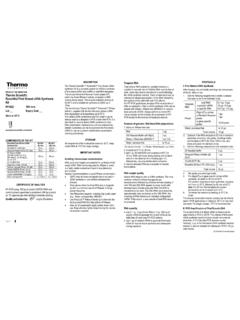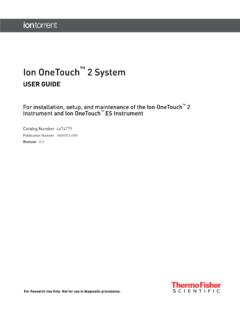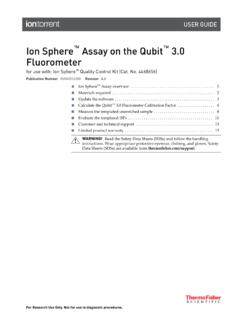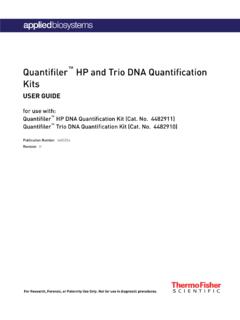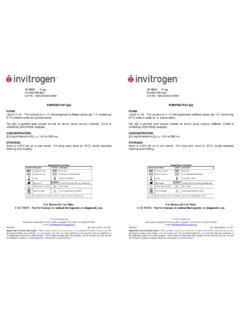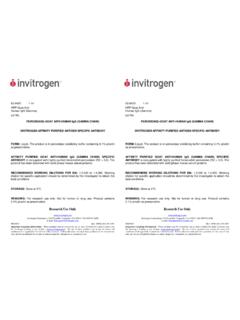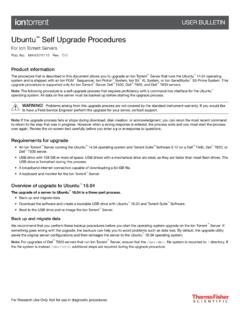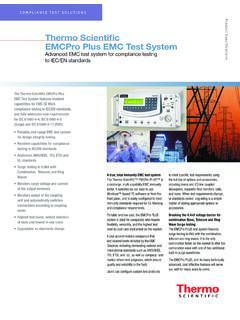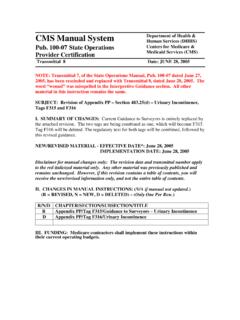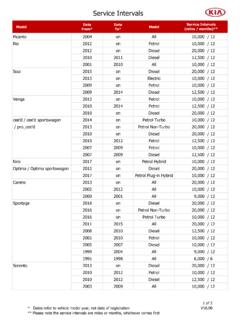Transcription of Proper Care and Maintenance for a Cell Culture Incubator
1 IntroductionThere are many different CO2 incubators today, in different labs around the world. They all share some similarities. You trust your work your cells to your Incubator . Having a well designed, properly functioning Incubator means that you will never have to worry about it. In such an Incubator , your cells will grow well, contamination problems are rare, and the Incubator is easy to clean and maintain. Everyone using a cell Culture Incubator needs to understand a few important points in order to keep any Incubator working its very best. The information presented here will help you to avoid common mistakes that can result in project delays. Please note that while these recommendations are generally applicable for any CO2 Incubator , we suggest that you consult your user manual to ensure you are also following the manufacturer s best NOTEP roper care and Maintenance for a Cell Culture IncubatorKeywordsCO2 Incubator Maintenance , disinfectant, cleaning, calibration, HEPA filterNote: If an automated heat decontamination/sterilization cycle is available, you can skip the manual disinfection step and simply run the automated program assuming the program is proven to eliminate accepted biological indicator organisms.
2 An automated high heat program also eliminates the need for autoclaving any internal parts. It s important to mention that while recent Thermo Scientific models with a high temperature cycle require no handling of parts to run the cycle, some earlier models and many from other manufacturers have sensors that must be removed first. When the Incubator is clean, disinfected, and the shelf parts are in place, you can install any additional optional parts such as an oxygen sensor or HEPA in-chamber HEPA filtration system in any Thermo Scientific CO2 Incubator will filter the entire chamber air volume every 60 seconds, establishing ISO-Class 5 cleanroom air quality in the chamber in 5 minutes after every door : A HEPA filter which is not located inside the chamber will not experience the same conditions as your cells and cannot provide the same level of assurance. Handle HEPA filters and gas sensors very carefully, as they are easily damaged.
3 If you have a water jacketed Incubator , fill the water jacket at this time. Also, fill the humidity pan with sterile distilled water, to inch ( cm) from the top, or fill only to the max indicator if available. Keeping the water pan full is important for good, consistent humidity and best growth conditions. Now, using the electronics and following the manufacturer s directions, set the temperature, over-temperature, under-temperature, CO2 and O2 setpoints, and the appropriate alarms. If you have a Thermo Scientific Incubator with the Thermo Scientific iCAN interface, you can also set the data logging parameters at this time. Depending on your settings, the iCAN will collect data to be stored onboard for up to a week, or exported to Microsoft Excel . This information can often be very useful, not only for cGMP (current Good Manufacturing Practice) monitoring, but also in helping to pinpoint the start of any the CO2 IncubatorWhere you place the Incubator can alter its performance.
4 Ventilation, air flow, room temperature, and direct sunlight can all affect the temperature and humidity installing a CO2 Incubator , be sure to lift only by the sides of the bottom, never from front and back and do not ever lift using the door. Position the Incubator on a firm, level surface away from any vibration source. Do not place any Incubator directly on the floor. Instead, use a support stand. If the Incubator sits directly on the floor, the air movement that is created each time the door is opened will sweep dirt, dust and contaminants directly into the Incubator chamber. When stacking incubators, you should only stack similar brands. If you stack dissimilar units, you risk the stack tipping over or the top unit slipping off, since there is generally no mechanism to secure incubators that don t , ensure there is adequate clearance on all sides of the Incubator . This allows for ventilation and access to power cords and connectors including gas hookup.
5 Try to place the Incubator away from traffic areas, but avoid damp, humid corners that may harbor fungal growth. Make sure the unit is sheltered from ventilation and other airstreams, because these air currents can direct contamination-carrying dirt and dust into the Incubator . Do not position the Incubator in direct sunlight, because fluctuating temperatures outside can affect the anti-condensation functions. Finally, ensure that the Incubator is level both front to back and side to side by adjusting the leveling feet or Incubator model is different regarding connections and programming, but there are some general guidelines that apply to all incubators. Properly installing the Incubator from the beginning will help provide the best conditions for your cells going the Incubator is properly positioned, clean and disinfect the Incubator interior, the shelves and shelf supports, and air ducts if applicable (see below for cleaning recommendations).
6 After disinfection, install these and any other internal components, following the manufacturer s directions. filter and then to the labeled serrated fitting on the back of the Incubator , and be sure to use a hose clamp and to check for gas leaks, which could be dangerous to you and your lab mates. When the Incubator has been operating normally for 24 hours, check the calibration of the temperature using a NIST (National Institute of Standards and Technology) or other certified thermometer, and check the CO2 using a fyrite or external IR Extra EquipmentSome researchers want to add electrical equipment such as shakers, rotators or stirrers to the CO2 Incubator . The difficulty with this is that too much heat from added equipment raises the internal temperature in the Incubator , and that extra heat makes it challenging for the Incubator electronics to compensate. Some shakers create vibration as well as heat, so it s important to not set the rotation faster than about 200 RPM (revolutions per minute), to minimize motion that can affect adherent cell attachment and growth.
7 Test your shaker at different speeds with your required volume of liquid and flasks to ensure no heat or vibration is produced, before experimenting with cells. If you know you will be using electrical equipment inside, consider purchasing a water jacketed Incubator configured with a cooling coil and chiller that will compensate for the extra heat an alternative to a shaker, the Thermo Scientific Heracell 240i offers a roller bottle assembly, which does not produce heat. Each substitutes for a shelf, so you can add up to 4 of these units inside, giving you added culturing flexibility. Reducing ContaminationTo reduce chances of contamination in your cultures, the cleanliness of your lab is important. Dust and dirt can fly around in the lab, carried by air currents created when people move about in the room or open and close doors. Normal indoor room air contains 100-1,000 microorganisms per cubic meter2, all circulating at any given moment.
8 Most of these come from the trillions of normal flora that live in and on our skin. This means that every time you open any Incubator door, contaminants can enter. So it s important to minimize contaminants and dirt in the lab by cleaning the lab often; at least one to two times per month. Clean and disinfect the biological safety cabinet (BSC), the water bath, the centrifuge, and microscope. Eliminate cardboard storage in or around refrigerators and freezers because the cardboard can get wet and then breed fungi. Do not store items on top of the Incubator , CO2 MonitoringThere are two kinds of CO2 gas sensors. The first is the T/C (thermal conductivity) sensor. Thermo Scientific incubators offer a T/C sensor and electronics that are very stable, accurate and economical. In fact, T/C sensors are our most popular method of CO2 control. They are long-lasting, comparatively inexpensive and robust. An IR (infrared) sensor is preferred for some applications including cGMP monitoring, or when the Incubator door is opened repeatedly over a short period; for example, when performing time lapse expression manufacturers have a design that places the sensors outside the incubation chamber to avoid the need to remove them during sterilization; this is not a good option because exterior sensors will not experience the same conditions as your cells do.
9 Thus, these incubators will not respond quickly to changes that affect cell Gas HookupsFor connecting CO2 tanks to Thermo Scientific incubators, you must use a two-stage CO2 pressure regulator on the outlet valve of the gas cylinder. This is because the input pressure on our incubators must be maintained at 15 +/- 5 psi (pounds per square inch) (1 barr) for the Proper functioning of the CO2 control system. A single stage regulator simply will not maintain this pressure, with resulting inaccurate CO2 levels. We recommend using industrial grade gas that is at least pure, because impurities in the gas can negatively affect your cells. The CO2 gas tank should not contain siphon tubes. Use a 2-stage regulator on the tank, and set the input pressure to the Incubator at 15 psi (1 barr). Connect the tubing to the air because dust and dirt among these items can be swept inside the chamber with air currents created during a door opening.
10 Remember to also clean the corners of the lab and on top of and under equipment where dust can DisinfectantsMany researchers ask: which disinfectants are okay to use in the CO2 Incubator ? The truth is that there are many disinfectant options available, but not all are safe for your cells or for Incubator components. Some strong disinfectants may give off fumes that enter the Incubator and then affect cell growth. These fumes contain VOCs (volatile organic compounds) that can induce expression of heat shock and other stress proteins. Common laboratory chemicals such as phenol, isoamyl alcohol and beta-mercaptoethanol are VOCs, but also laboratory cleaning products and disinfectants, and even floor cleaners and waxes produce harmful vapors. In short, if it smells strong or bad to you, it can also be bad for your cultured cells. Recognizing that VOCs are an increasing concern for cell culturists, some Thermo Scientific incubators with HEPA filtration will accept specialized HEPA filters that also capture Fisher Scientific s Technology Team investigated and tested a number of different types of disinfectants.
